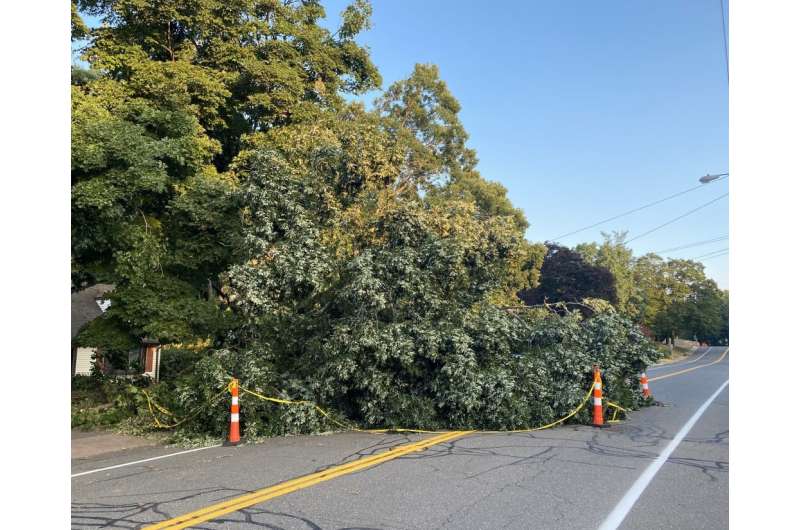A fallen tree in the aftermath of Tropical Storm Isaias in 2020. Credit: Tom Breen/UConn
Eversource Energy's tree trimming program led to 900 fewer tree-caused power outages per year, according to research done by UConn energy analysts and published this month in the journal Energy Policy. For tree-caused power outages that did occur, the duration was reduced by 54%, meaning 18,000 fewer customers experienced tree-caused power outages every year the study looked at.
Power outages are a common occurrence for those living in Connecticut. An almost entirely above-ground electricity distribution network paired with a highly forested landscape provides ideal conditions for frequent power outages. Utility companies trim the trees around power lines to try to reduce the number of power outages. But tree trimming is both costly and labor intensive, as well as contentious in many towns where historic trees can clash with modern power lines. The study addressed whether trimming trees actually reduces outages, and whether there might be other equally cost-effective measures.
"Trimming trees to prevent power outages might seem obvious at first, but this analysis helps us determine where tree trimming will provide the most benefit to the electricity grid and where it won't," says lead author Adam Gallaher, a Ph.D. student in the Department of Geography and Team TERRA NSF-NRT Fellow. The findings from the study were presented to Eversource Energy and at the annual Eversource Energy Center Meeting held on November 19.
Gallaher and his co-authors analyzed how effective the Eversource tree-trimming program is at reducing the number of tree-caused power outages in Connecticut from 2009 to 2015. But that part of the analysis only accounted for where tree trimming actually occurred. So Gallaher and his co-authors also quantified how many tree-caused power outages were avoided in places where trees were not trimmed by trimming trees elsewhere. What they found was that on average, the frequency of tree-caused power outages was reduced by 737 fewer outages per year. The duration of tree-caused outages that did occur was reduced by an average of 88,000 minutes, and 19,446 fewer customers on average were affected by tree-caused power outages during the duration of the study.
Eversource Energy, New England's largest investor-owned utility, provides electricity for the majority of Connecticut, around 84% of the state. Eversource is often required by the state legislature to undertake various improvements and reliability measures. Beginning in 2007, Eversource started trimming trees as their method for increasing the resiliency and reliability of the electrical grid. On average, U.S. consumers pay around 11 cents per kilowatt-hour of electricity. In Connecticut that rate hovers around 19 cents per kilowatt-hour. Customers know they're paying a premium and expect reliable electricity year-round.
"This information can help improve and optimize Eversource's tree trimming program, helping Connecticut residents and business owners keep their lights on, and keep money in their pockets," Gallaher says.
More information: Adam Gallaher et al, Legacy and shockwaves: A spatial analysis of strengthening resilience of the power grid in Connecticut, Energy Policy (2021). DOI: 10.1016/j.enpol.2021.112582
Journal information: Energy Policy
Provided by University of Connecticut
























